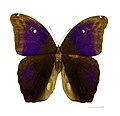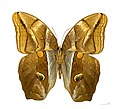
The morpho butterflies comprise many species of Neotropical butterfly under the genus Morpho. This genus includes more than 29 accepted species and 147 accepted subspecies, found mostly in South America, Mexico, and Central America. Morpho wingspans range from 7.5 cm (3.0 in) for M. rhodopteron to 20 cm (7.9 in) for M. hecuba, the imposing sunset morpho. The name morpho, meaning "changed" or "modified", is also an epithet. Blue morphos are severely threatened by the deforestation of tropical forests and habitat fragmentation. Humans provide a direct threat to this spectacular creature because their beauty attracts artists and collectors from all over the globe who wish to capture and display them. Aside from humans, birds like the jacamar and flycatcher are the adult butterfly’s natural predators.

Archaeoprepona demophon, the one-spotted prepona, banded king shoemaker, or demophon shoemaker is a butterfly belonging to the family Nymphalidae.

Cethosia biblis, the red lacewing, is a species of heliconiine butterfly belonging to the family Nymphalidae.

Morpho achilles, the Achilles morpho, blue-banded morpho, or banded blue morpho, is a Neotropical butterfly.
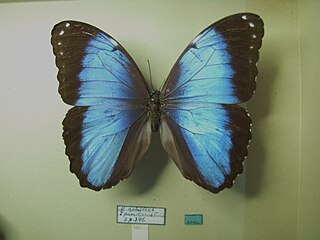
Morpho helenor, the Helenor blue morpho or common blue morpho, is a Neotropical butterfly found throughout Central and South America from Mexico to Argentina. It is a species group that may or may not be several species. Many subspecies have been described.
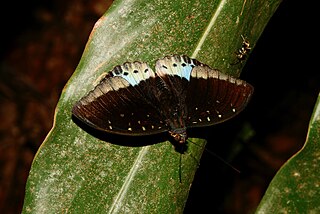
Lexias pardalis, the common archduke, is a butterfly of the family Nymphalidae.
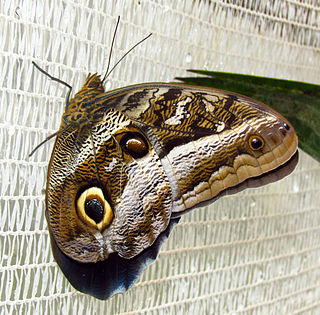
Caligo idomeneus, the Idomeneus giant owl, is a butterfly of the family Nymphalidae. The species can be found in the Amazon rainforest and eastern Andes, from Venezuela to Ecuador, and south to the Mato Grosso in southern Brazil. The butterfly is named for Idomeneus, the leader of the Cretan army during the Trojan War.

Biblis hyperia, the red rim or crimson-banded black, is a species of brush-footed butterfly that is native to the lower Rio Grande Valley of Texas in the United States, Mexico, the Caribbean, Central America, and South America as far south as Paraguay. Its genus Biblis is so far monotypic, but at least one other undescribed species is suspected to exist.

Panacea prola, the prola beauty or red flasher, is a species of butterfly of the family Nymphalidae. It is found from Costa Rica to southern Brazil, but is most common in the foothills of the eastern Peruvian Andes.

Prepona laertes, the shaded-blue leafwing or Laertes prepona, is a butterfly of the family Nymphalidae. It is found in large parts of Central and South America.

Heliconius numata, the Numata longwing, is a brush-footed butterfly species belonging to the family Nymphalidae, subfamily Heliconiinae.

Pieriballia is a genus of butterflies in the family Pieridae erected by Alexander Barrett Klots in 1933. Its only species, Pieriballia viardi, the painted white or viardi white, was first described by Jean Baptiste Boisduval in 1836. It is found from Mexico to Bolivia and Paraguay. Strays can be found in southern Texas in the United States. The habitat consists of rainforests and transitional cloud forests.
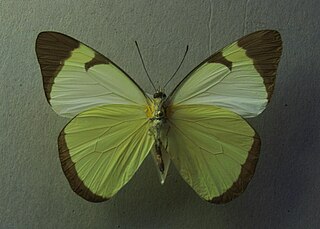
Melete lycimnia, the common melwhite, primrose flag or lycimnia white flag, is a butterfly in the family Pieridae. It is found from Texas in the United States to Bolivia. The habitat consists of lowland rainforests.

Opsiphanes cassina, the split-banded owlet, is a species of butterfly belonging to the family Nymphalidae.

Doxocopa laurentia, the turquoise emperor or Cherubina emperor, is a species of butterfly of the family Nymphalidae, subfamily Apaturinae.

Doxocopa agathina, the agathina emperor, is a species of butterfly of the family Nymphalidae. It is found in the Guyanas, northern Brazil, and the Amazon region. It is also called the purple emperor but this name may also refer to the European butterfly Apatura iris.

Marpesia zerynthia, the waiter daggerwing, is a species of butterfly in the family Nymphalidae. Primarily found in Mesoamerica, it can also be observed in regions slightly north and south of this area.

Eryphanis is a genus of owl butterflies in the family Nymphalidae.
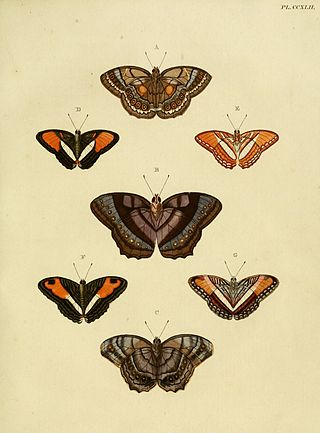
Adelpha cocala, the cocala sister or orange-washed sister, is a butterfly of the family Nymphalidae. It was described by Pieter Cramer in 1779. It is found from Honduras to Panama, Guatemala, Venezuela, Colombia, Suriname, Peru, Bolivia and Brazil.

Caligo teucer, the Teucer owl butterfly is a butterfly of the family Nymphalidae. It was described by Carl Linnaeus his 1758 10th edition of Systema Naturae. It is found from Colombia and Venezuela to Bolivia and Paraguay. The habitat consists of rainforests and cloudforests at altitudes ranging from 400 to 1,400 meters.

